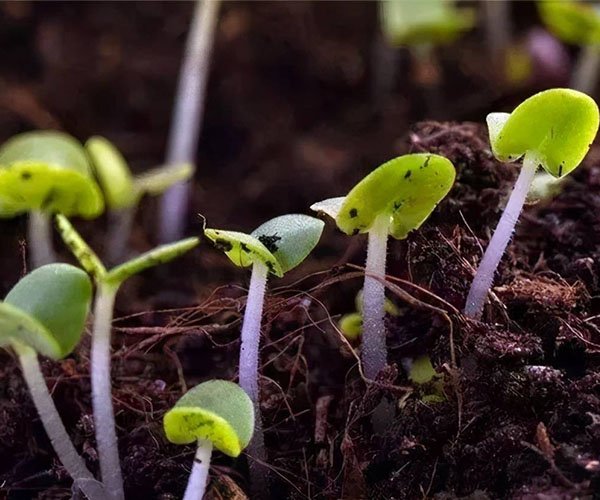As the global climate changes, drought is already a major problem we face. In addition, over-cultivation and heavy soil loading lead to a decline in soil organic matter content. Biostimulant products can promote crops’ tolerance to water stress through direct and indirect ways, among which humic acid has been widely recognized for improving crops’ drought resistance.
1. The effect of humic acid on soil water retention capacity
Humic acid can promote the formation of soil aggregate structure. The essence is the cementation of humic acid to form an organic-inorganic complex aggregate, which has water stability and mechanical stability. Studies have shown that the application of humic acid substances on desertified land can increase the content of water-stable microaggregates larger than 0.25mm in the soil by 32% to 72% compared with the control.
The aggregate structure is mainly the gel in which the humic acid in the soil interacts with the calcium ions in the soil to form flocculent precipitates. This colloid can well cement the soil together to form a water-stable aggregate structure, that is, a stable aggregate that is not easy to disperse when exposed to water. Secondly, this kind of aggregate structure can unify the permeability, absorption and storage of water and air. Its cation substitution capacity is 4-5 times larger than that of clay particles, and its water absorption rate is 10 times that of clay particles. By improving the three aspects of water, nutrients and air to meet the needs of plants for the growth environment.
It not only improve the growth environment of crops, but also improve the living environment of soil microorganisms. The large-scale reproduction of microorganisms promotes better soil aggregates, lower soil bulk density, increased porosity, and good permeability. Sex, reduce soil capillary action, so as to achieve the effect of soil water retention.
2. The structure of humic acid itself is hydrophilic
Humic acid is a kind of natural organic macromolecular polymer, these macromolecules are composed of several similar structural units. Each structural unit compose three main parts: aromatic ring, bridge bond and active group. The aromatic rings are connected by bridges, and there are various active groups on the aromatic rings. Among them, oxygen is the main element that constitutes the functional group, such as phenolic hydroxyl group, quinone group, carboxyl group, carbonyl group, methoxyl group, etc. The existence of these functional groups determines that it has properties such as acidity, hydrophilicity, cation exchange, and complexation of metal ions.
The main way to enhance the structural hydrophilic function:
- Increase the content of humic acid functional groups.
- Improve the solubility of humic acid in water
The carboxyl group and phenolic hydroxyl group of humic acid are acidic, have cation exchange performance and complexation ability, and can form soluble and insoluble salts and complexes with different degrees of stability with ammonium ions, alkali metal ions, and trace element ions. The surface tension of the corresponding metal complex is lower than that of water.
Studies have shown that the increased content of hydroxyl and carbonyl groups makes the hydrophilicity of humic acid significantly higher than that of traditional sulfonation. This is due to the interaction between the lone pair of electrons of the oxygen atoms in the hydroxyl and carbonyl groups and the hydrogen in the water molecules to generate hydrogen bond, the effect of hydrogen bond greatly improves the solubility of humic acid in water, thereby improving the water retention capacity of humic acid in soil. In principle, a carbonyl group can also form hydrogen bonds with water molecules. Meantime, the increase in the number of carbonyl groups can greatly improve the ability to resist alkali metal ions.
3. The effect on improving the antioxidant capacity of crops
It has an excellent effect on improving crop resistance to drought, salinity, high temperature, low temperature, and pest stress. These effects all come from the good biostimulation effect of humic acid.
Studies have shown that spraying humic acid under drought conditions can promote the increase of proline content in wheat leaves. The free proline in plants under drought stress is conducive to the recovery of growth after the adversity is relieved and to avoid plant poisoning. It is conducive to stabilizing the structure of proteins, and improving the water environment of cell membranes and other macromolecular substances. Thus, the application of humic acid promoted the water holding capacity of the cells and also improved the drought resistance.
Drought stress will cause oxidative stress in crops, which will accumulate reactive oxygen species (ROS) substances in crop cells, cause cell oxidation, and lipid peroxidation in cell membranes. Eventually leading to cell death, showing plant physiological apoptosis. Humic acid can activate the activity of antioxidant enzymes and the synthesis of antioxidants in cells. So that cells can remove excess ROS and protect cell membranes. Help activate the activities of superoxide dismutase (SOD), peroxidase (POD), catalase (CAT) and the activity of reduced glutathione (GSH), carotenoid (Car) in crops content. By activating the antioxidant system to remove excess ROS under drought stress, reduce the content of membrane lipid peroxidation product malondialdehyde (MDA), protect cell membranes, and enable crops to resist physiological oxidative stress caused by drought stress.


